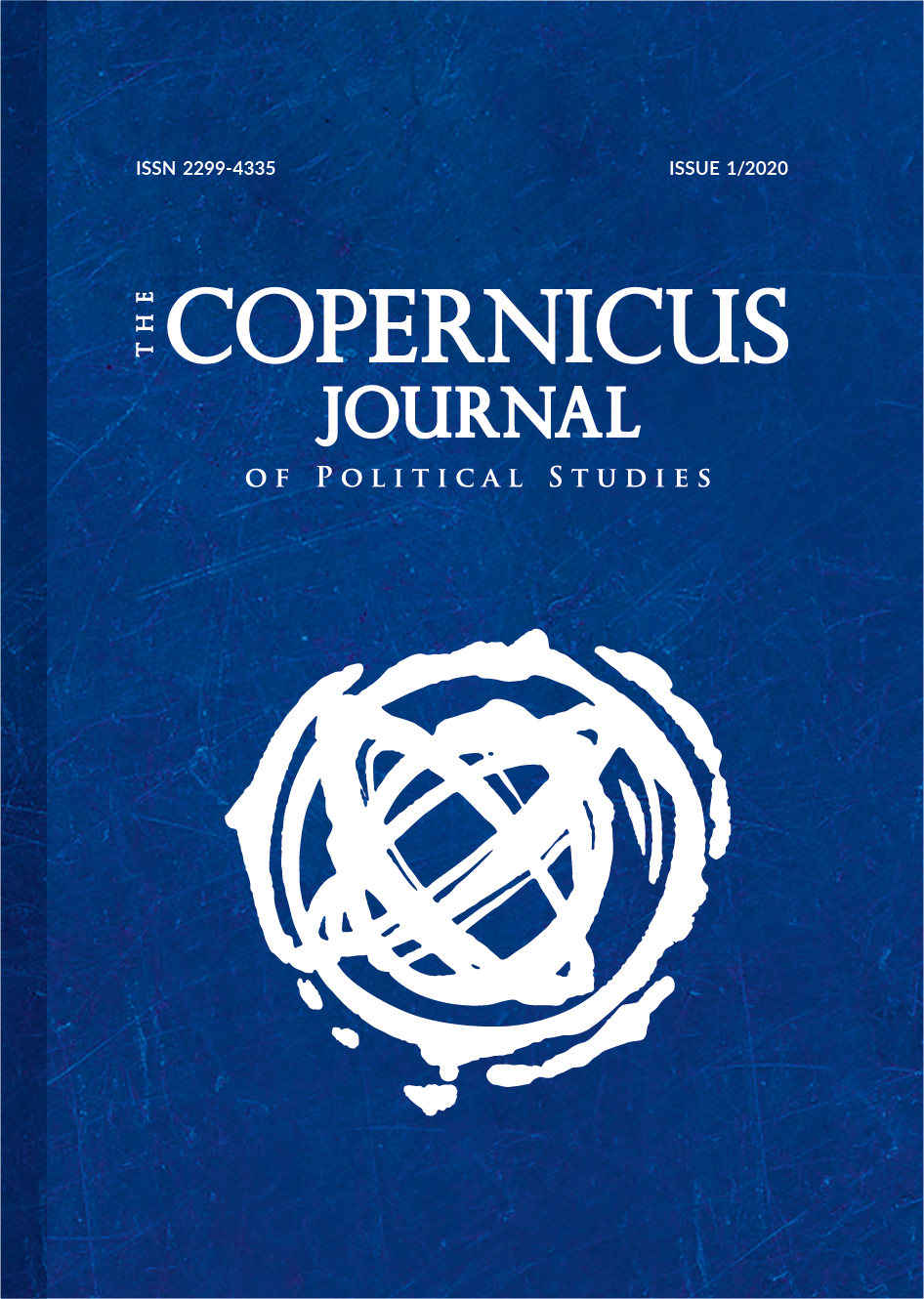ENERGY SECURITY IN THE EUROPEAN UNION
DOI:
https://doi.org/10.12775/CJPS.2020.002Słowa kluczowe
European Union, state’s energy security, assessment of energy reliability, state’s energy security indicesAbstrakt
The aim of the article is to present a practical and methodological approach to assessing the energy security of European countries, with particular focus on states with coal-dependent energy systems and on finding balance between ensuring energy security, diversification of energy resources and environmental protection. As energy security means technically reliable, stable, cost-effective and environmentally balanced supply of energy resources to satisfy the needs of the economy and the population, the author proposes an indicator that takes into consideration different components, and can be a helpful tool in designing energy policies. The article also discusses using the energy potential of closed coal mines.
Bibliografia
Aland, F. (2013). European Energy Efficiency Policy. Retrieved from http://energohelp.net/articles
Amosha, A., & Skubenko, V. (2015). The economic policy of the state and its impact on the activities of enterprises. Ekonomika promyslovosti - Donetsk: IEP HAH Ukraine, 1/2015, 3-12
Astakhov, A. S., Dikolenko, E. Y., & Kharchenko, V. A. (2009). Environmental safety and environmental management. Mining book. Moscow: Publishing House of the Moscow State University.
Baeten, G., Swyngedouw, E., & Albrechts, L. (1999). Politics, Institutions and Regional Restructuring Processes: From Managed Growth to Planned Fragmentation in the Reconversion of Belgium’s Last Coal Mining Region. Regional Studies, 1999, 247–258
Bakanov, S. (2015). The concept of “old industrial regions” in historical and economic research: problems of theory and historiography. Magistra Vitae: electronic journal on historical sciences and archeology, 24(379), 160–167.
Bardas, A. (2011). The principles of environmental certification in the conditions of field restructuring. Dnipro: National Mining University, Institute of Economy, National Academy of Sciences of Ukraine.
Borisov, V. N., & Cheplyansky, Y. V. (2015). Microeconomics (in 5 volumes). Vol. 5. St. Petersburg: Economic School.
Bravard, J. L., & Morgan, R. (2007). Effective Outsourcing. Understanding, Planning and Using Successful Outsourcing relationships. Moscow: Balance Business Books.
Brodsky, V. A. (2013). Comparison of two methods for determining the boundaries of commodity markets: a test of a hypothetical monopolist and a pairwise comparison method. Modern Competition, 5(41). Available at http://www.moderncompetition.ru/e/articles/index.php?article_id_4=1529
Bugay, S., & Kulik, O. (2002). Depressed regions: experience of the countries of the European Union. Coal Market, 2/2002.
Commission of the European Communities. (2006). A European Strategy for Sustainable, Competitive and Secure Energy. Energy Overview: An Energy Policy for Europe. Communication From the Commission to the European Council and the European Parliament. Retrieved from http://ec.europa.eu/dgs/energy_transport /figures/pocket- book/2006_en.htm
European Parliament. (2015). Privacy and Data Protection implications of the civil use of drones. PE 519.221, 2015. Retrieved from http://www.europarl.europa.eu/RegData/etudes/IDAN/2015/519221/IPOL_IDA%282015%29519221
Hancher, L., Ottervanger, T., & Slot, P. (2012). EU State Aids. London: Sweet & Maxwell.
Hellmer, S., & Wárell L. (2009). On the evaluation of market power and market dominance – The Nordic electricity market. Energy Policy, 37, 3235–3242.
Heywood, J. B. (2004). Outsourcing: In Search of Competitive Advantage. Outsourcing Dilemma: The Search for Competitiveness. Moscow: Williams.
Kasper, H., & Etil, B. (2012). The aftermath of the closure of the Dutch coal mines in South Limburg: Regional economic and social reconstruction. Retrieved from https://nowa-energia.com.pl/wp-content/uploads/2013/03/raport_uniwersytet_w_maastricht_en.pdf
Kozachenko, A. V., Kozachenko, V. P., & Ponomarev, V. (2003). Economic security of the enterprise: the nature and mechanisms of support. Kiev: Libra.
Kuznetsova, A. V. (Ed.). (2009). Regional policy of the EU countries. Moscow: Publishing House of the IMEMO RAS.
Mamaikin, O., Sotskov, V., Demchenko, Y., & Prykhorchuk, O. (2018). Productive flows control in coal mines under the condition of diversification of production. E3S Web of Conferences, 60. DOI: https://doi.org/10.1051/e3sconf/20186000008
Mamaykin, А. (2012). Ecological Aspects of the quantitative assessment of productive streams of coal mines: Geomechanical Processes During Underground Mining. London: Taylor & Francis Group.
Melnik, A., Shy, O., & Stenbacka, R. (2008). Assessing market dominance. Journal of Economic Behavior & Organization, 68, 63–72.
Melnikova, S. (2013). Decarbonization of European energy: goals and realities. Modern science: research, ideas, results, technologies, 2(13), 168–172.
Music, O. (2011). Bifurcations in nature and society: the natural science and socio-synergetic aspect. Modern high technology, 1/2011, 87–91. Retrieved from http://www.top-technologies.ru/ru/article/view?id=26640
Olszanecka, N. (2018). Russian energy sector in the face of sanctions. The Copernicus Journal of Political Studies, 1/2018, 5–18. Retrieved from https://apcz.umk.pl/CJPS/article/view/CJPS.2018.001/24726
Pavlenko, I. & Trifonova, O. (2005). Vugіlna mine in the aspect of targeted investment. Academic look, 2/2005, 62–66.
Pivnyak, G., Amosha, A. I., & Yashchenko, Y. P. (2004). Reproduction and investment processes in the coal industry. Kiev: Scientific Thought.
Pivnyak, G., Pilov, P., Bondarenko, V., & Sally V. (2005). Internal reserves of increasing the efficiency of the coal industry in the conditions of market transformation of the Ukrainian economy. Mining Journal, 5/2005, 61–64.
Pivnyak, G., Sally, V., & Baysarov, L (2003). Investments in the coal industry: reality and forecasts. Coal of Ukraine, 5/2003, 4–8.
Raichel, B. L., & Pavlenko, I. I. (2006). Objects of investments and possible sources of financing in the coal industry. In Problems of the foreign economic relations development and foreign investment attraction: regional aspect, Vol. 3 (pp. 34–37). Donetsk: DonNU.
Rozhkov, A. (2015). Structural transformations in the coal industry and regions: World experience, problems, prospects. A Collection of articles. Saarbrücken: LAP LAMBERT Academic Publishing.
Sajduk, B. (2019). Theoretical premises of the impact of artificial intelligence on international relations and security. The Copernicus Journal of Political Studies, 2/2019, 157–180. Retrieved from https://apcz.umk.pl/CJPS/issue/view/1820
Trifonova, O. V. (2015). Management of sustainable coal mining enterprises operation: theory and practice: National Mining University. Dnepropetrovsk: NMU.
Voronchenok, A., Tikhomirov, A., & Skorodumov, S. (2006). Outsourcing of high technology to create new technology. Moscow, n.p.
Zimakov, A. (2017). Is there a future for coal-fired power plants in Europe? Bulletin of MGIMO University, 5(56), 130–150.
Pobrania
Opublikowane
Jak cytować
Numer
Dział
Licencja
Prawa autorskie (c) 2020 The Copernicus Journal of Political Studies

Utwór dostępny jest na licencji Creative Commons Uznanie autorstwa – Bez utworów zależnych 4.0 Międzynarodowe.
Statystyki
Liczba wyświetleń i pobrań: 607
Liczba cytowań: 0



